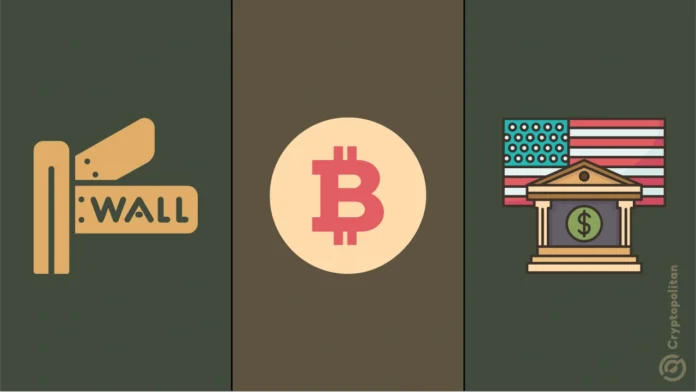Jai Hamid
Bitcoin continues its meteoric rise while Wall Street reels from the Federal Reserve’s mixed messages on interest rates. The Dow Jones Industrial Average plunged 305.87 points, or 0.70%, ending Friday at 43,444.99.
The S&P 500 didn’t fare any better, sliding 1.32% to 5,870.62. Meanwhile, the Nasdaq Composite saw the sharpest drop, falling 2.24% to close at 18,680.12. This week’s collapse in equities was seemingly the end of the post-election rally that had momentarily lifted markets.
Fed’s wait-and-see approach sends Wall Street into a spiral
It was a brutal week for stocks. The S&P 500 fell 2.1% over the last five trading days, the Nasdaq tanked 3.2%, and the Dow slipped 1.2%. Wall Street’s confidence has been shaken. Traders looking for clarity were hit with vague reassurances instead, leaving the markets bleeding red.
Federal Reserve Chair Jerome Powell struck a cautious tone on Thursday, saying the central bank isn’t in any rush to lower interest rates. He made it clear that the U.S. economy’s strong growth provides policymakers with the luxury of time.
“The economy is not sending any signals that we need to be in a hurry to lower rates,” Powell said, speaking to business leaders in Dallas. “The strength we are currently seeing in the economy gives us the ability to approach our decisions carefully.”
Adding to the uncertainty was Boston Fed President Susan Collins echoed Powell’s hesitation, telling The Wall Street Journal that a December rate cut isn’t guaranteed. Economic data hasn’t helped calm the waters.
October retail sales rose 0.4%, slightly above economists’ expectations of 0.3%, but it wasn’t enough to soothe the jittery markets. Nonfarm payrolls increased by just 12,000 in October, a figure Powell attributed to labor strikes and storm damage in the Southeast. Although unemployment remains historically low, it has been creeping up and flattening in recent months.
Kristy Akullian, head of iShares investment strategy at the pro-Bitcoin BlackRock, called the current environment “micro volatility,” adding that the way forward will likely be rocky as our markets adjust to the changing policies. In her words:
“We expect the U.S. equity market to continue to move higher, but don’t expect that rise to happen in a straight line.”
President-elect Donald Trump’s announcement of vaccine skeptic Robert F. Kennedy Jr. as his pick to lead the Department of Health and Human Services sent the SPDR S&P Biotech ETF down more than 5%—its worst week since 2020. Amgen and Moderna were among the worst-hit, falling 4.2% and 7.3%, respectively.
Tech wasn’t spared either. The information technology sector of the S&P 500 fell more than 2%, with heavyweights like Nvidia, Meta Platforms, Alphabet, and Microsoft taking significant hits.
Tesla stood out as a rare bright spot, with its stock climbing 3%, likely strengthened by its perceived alignment with Trump’s economic policies. So now the EV giant is an outlier in a sector otherwise dragged down by volatility and uncertainty.
Bitcoin powers through market turmoil
While stocks crumbled, Bitcoin continued its unrelenting climb, comfortably stabilizing above $90,000. The cryptocurrency has surged 32% since Election Day and is now closing in on $100,000. Analysts say this is just the beginning.
Dhaval Joshi, an analyst at BCA Research, predicts Bitcoin’s long-term price could exceed $200,000. He attributes this to Bitcoin’s role as a “non-confiscatable asset”—a hedge against hyperinflation, banking collapses, and government overreach.
Joshi compares Bitcoin to gold, noting its growing appeal as a store of value. “Bitcoin, with a market value of $1.5 trillion, comprises less than 10% of the total market for non-confiscatable assets,” he said. “As Bitcoin’s share of this market increases, and the supply of bitcoins reaches its upper limit, Bitcoin’s price has substantial upside.”
This week alone, Bitcoin posted a 16% gain, even after a brief pause in the rally on Tuesday. The bull run has been fueled by a combination of factors, including increasing adoption and its perceived independence from traditional financial systems.
Is the BTC-Dow correlation a thing of the past?
Interestingly, Bitcoin’s relationship with traditional markets has transformed. In September, the correlation between Bitcoin and major stock indices reached an all-time high of 50%. Historically, Bitcoin was viewed as uncorrelated with traditional assets, but that narrative has dramatically changed.
Events like the COVID-19 pandemic and economic downturns have shown Bitcoin and stocks moving in tandem, particularly during risk-off periods. Despite its reputation for volatility, Bitcoin has reacted to investor sentiment in ways that mirror traditional equities.
For instance, both markets tend to decline during periods of uncertainty as investors retreat to safer assets like gold. Yet, Bitcoin’s volatility still sets it apart. Its price swings are far more dramatic than those seen in traditional markets, creating opportunities for outsized gains—or losses.
The increased correlation concerned some analysts who feared that BlackRock taking over Bitcoin would be the worst thing to ever happen to it. Things seem to be getting back to normal though… for now.
